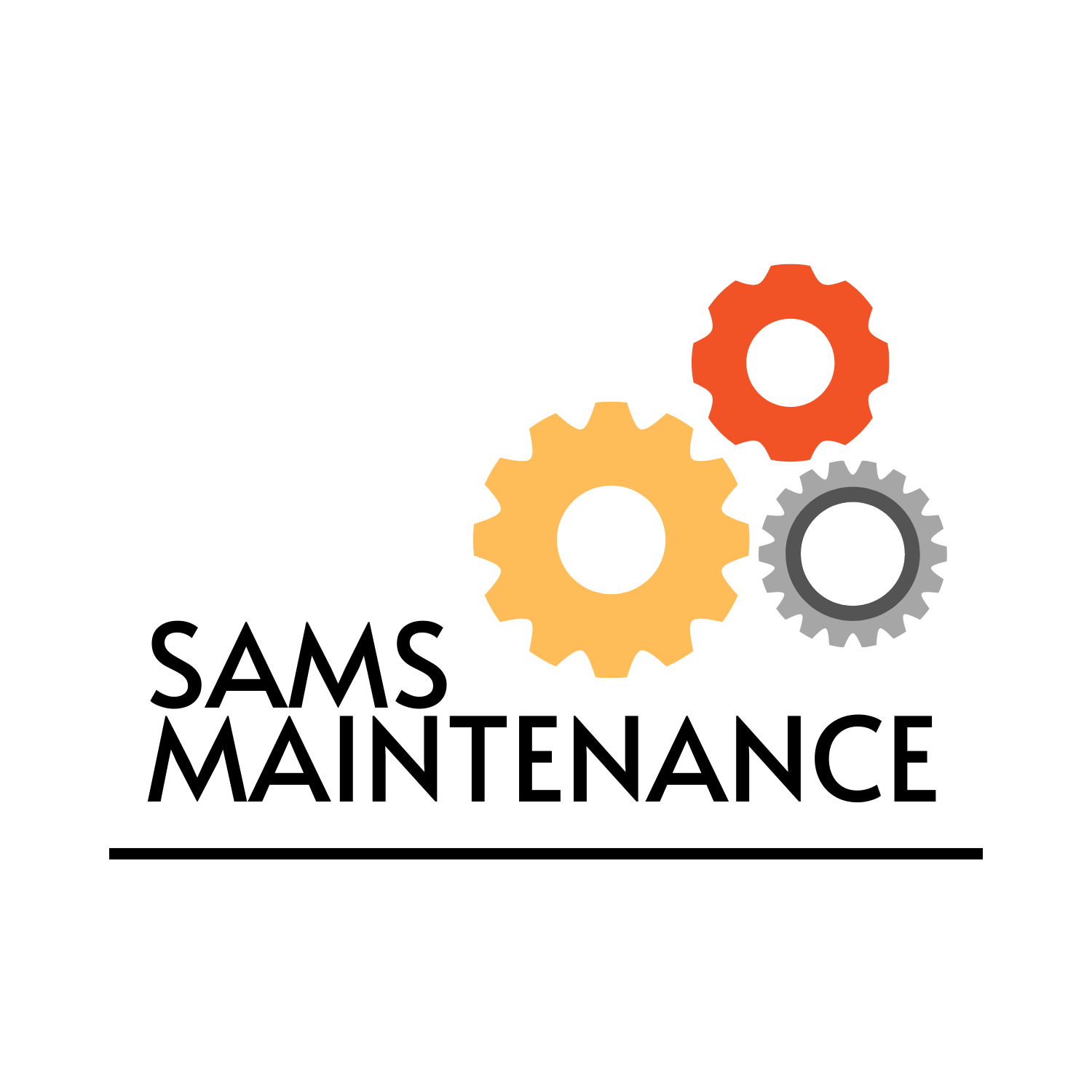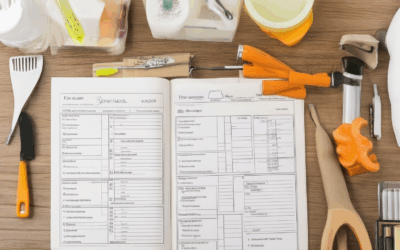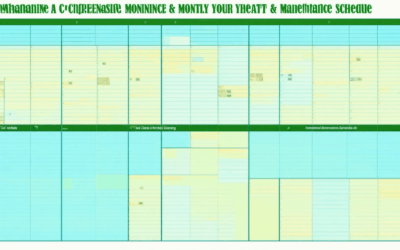Preventative home maintenance is a cornerstone of responsible homeownership, offering a proactive approach to safeguarding your property from costly repairs and ensuring its longevity. As any homeowner knows, neglecting routine checks and upkeep can lead to minor issues escalating into major problems, both inconvenient and expensive. By prioritizing regular maintenance, you not only protect your investment but also save yourself from unexpected expenses down the line. This comprehensive guide delves into the essential practices, annual tasks, and strategies that will help you maintain your home in peak condition, including the often-overlooked 1% rule for budgeting and planning. Whether you’re new to homeownership or looking to refine your current routine, this detailed overview will equip you with the knowledge and tools needed to keep your home in excellent shape. From creating a personalized checklist to understanding when to schedule inspections and replacements, we’ll cover everything you need to stay ahead of potential issues. Don’t wait until it’s too late—start your journey toward a well-maintained home today.
Key Takeaways
– Prioritize preventative maintenance to address potential issues before they escalate, ensuring your home’s longevity and safety.
– Conduct regular cleaning and inspections to catch damages early, such as peeling paint or loose shingles, and maintain interior spaces for a healthy living environment.
– Replace old fixtures and parts regularly to enhance functionality and energy efficiency.
– Schedule annual checks for plumbing, electrical, and HVAC systems to prevent breakdowns and ensure optimal performance.
– Understand the difference between preventative and routine maintenance, with the former focusing on proactive issue prevention and the latter on optimizing performance through scheduled tasks.
– Implement a combination of both maintenance strategies to extend equipment lifespan and reduce costs.
– Perform lawn care, gutter cleaning, and landscaping to maintain curb appeal and property value.
– Keep vehicles and office spaces running smoothly with regular oil changes, tire rotations, and plumbing checks.
– Always remember that consistent upkeep is essential for the functionality and longevity of your home, vehicles, and commercial spaces.

What is Preventive Home Maintenance?
Preventive home maintenance refers to routine tasks and checks designed to protect your home from potential damage, costly repairs, and early wear and tear. By addressing issues before they escalate, you can extend the lifespan of your property and ensure a safe living environment.
Key Components of Preventive Home Maintenance
- Gutters and Downspouts: Keep gutters free of debris and ensure water flows away from your home to prevent foundation issues and roof leaks.
- Exterior Surfaces: Inspect and clean siding, decks, and windows regularly to prevent deterioration and moisture buildup.
- HVAC Systems: Change filters, check ductwork for leaks, and schedule regular tune-ups to maintain efficiency and prevent breakdowns.
- Plumbing Systems: Regularly inspect pipes for leaks, test water pressure, and ensure waste lines are clear to prevent backups.
- Appliances: Clean and maintain cooking ranges, refrigerators, and laundry units to reduce strain and extend appliance life.
- Roofing and Attics: Check for missing shingles, inspect attic insulation, and ensure vents are clear to promote airflow and prevent mold growth.
Creating a Comprehensive Home Maintenance Checklist
Here’s a simple checklist to guide your preventive home maintenance efforts:
- Inspect exterior surfaces monthly for cracks or peeling paint.
- Test smoke detectors and carbon monoxide alarms quarterly.
- Scheduled HVAC service every 6 months.
- Check for leaky pipes or water damage monthly.
- Service major appliances annually, like dishwashers and ovens.
- Trim trees and bushes to prevent branches from touching your home.
- Inspect crawl spaces and basements for moisture or pests.
- Replace worn-out caulking and weatherstripping around doors and windows.
Tools and Resources for Homeowners
To perform preventive home maintenance effectively, consider investing in the following tools:
- A high-quality ladder for reaching hard-to-reach areas.
- A set of screwdrivers and adjustable wrenches.
- Infrared thermometers for checking pipe temperatures and appliance function.
- A digital camera to document issues and track progress.
- Sam’s Maintenance for professional guidance and resources.
Why Preventive Maintenance Matters
Regular preventive maintenance not only saves money in the long run but also ensures your home remains in excellent shape. By addressing small issues before they become big problems, you can enjoy a safer, more comfortable living space year-round.
Don’t wait until a problem arises—take proactive steps today to maintain your home’s health and longevity!
What Maintenance Does a House Need Every Year?
Annual home maintenance is crucial to ensure your property remains in great shape and avoids costly repairs. Here’s a detailed checklist to guide you through the essential tasks:
- Exterior Maintenance
- Inspect and repair roof for missing shingles or damage.
- Check siding for cracks, peeling, or damage.
- Examine windows and doors for proper sealing and functionality.
- Clean and check gutters and downspouts for blockages.
- Inspect decks, porches, and walkways for structural issues.
- Pressure wash exterior surfaces to remove dirt and grime.
- Interior Maintenance
- Check floors for warping, cracking, or unevenness.
- Inspect walls for peeling paint or water damage.
- Test smoke detectors and carbon monoxide alarms.
- Check plumbing for leaks under sinks, toilets, and showers.
- Clean and service appliances like the washer, dryer, and stove.
- Inspect water heater for rust or corrosion.
- Heating, Ventilation, and Air Conditioning (HVAC)
- Clean or replace air filters monthly and annually depending on usage.
- Inspect ductwork for leaks or blockages.
- Schedule a professional tune-up for your furnace or heat pump.
- Check the thermostat for proper programming and functionality.
- Plumbing and Water Systems
- Check for leaks around pipes and fixtures.
- Inspect underground pipes for damage or root intrusion.
- Test water pressure and ensure there are no discolored water issues.
- Flush water heaters to prevent sediment buildup.
- Electrical Systems
- Inspect circuit breakers and fuse boxes for damage or tripping.
- Check outlets and switches for overheating or malfunction.
- Ensure GFCIs (Ground Fault Circuit Interrupters) are installed and functioning.
- Test lighting fixtures and fans for proper operation.
- Landscape and Outdoor Features
- Inspect trees and shrubs for signs of disease or pests.
- Trim bushes and trees to maintain visibility and prevent encroachment.
- Check for dead branches that could fall and cause damage.
- Inspect outdoor lighting for functionality and safety.
- Ensure drains and sprinklers are working properly.
- Reseal driveways, patios, and walkways as needed.
- Additional Tips
- Hire a professional inspector to catch issues you might miss.
- Use a comprehensive checklist to stay organized.
- Stay informed about local building codes and regulations.
By tackling these tasks annually, you’ll extend your home’s lifespan and ensure it remains safe and comfortable for years to come. Regular maintenance also helps prevent unexpected repair costs and keeps your home looking its best!
Learn more about comprehensive home maintenance or explore our full range of services to keep your home in top shape.

The 1% Rule for Home Maintenance
The 1% rule for home maintenance is a helpful guideline for homeowners to budget and plan for ongoing upkeep. Here’s a breakdown:
- 1% of Home Value: Calculate 1% of your home’s appraised value to determine your annual maintenance budget. For example, if your home is valued at $200,000, set aside $2,000 annually.
- Regular Checks: Schedule regular inspections for systems like HVAC, plumbing, and roofing to catch issues early and avoid costly repairs later.
- Seasonal Tasks: Plan for seasonal maintenance, such as gutter cleaning (twice a year) and HVAC tune-ups (once a year), to ensure everything runs smoothly.
- Adaptability: Adjust your budget if your home’s value increases or decreases, as maintenance needs may change accordingly.
- Unexpected Expenses: Include a buffer for unforeseen repairs or replacements, ensuring you’re prepared for emergencies.
- Tracking Budgets: Use tools like spreadsheets or apps to monitor and manage your maintenance spending effectively.
- Long-Term Benefits: Consistent maintenance can enhance your home’s resale value, making it more attractive to potential buyers.
- Exceptions: Older homes or those in harsh climates may require more frequent upkeep, but the rule remains a useful starting point.
By following the 1% rule, you can maintain your home proactively, preventing minor issues from escalating and preserving its value over time.

What is General House Maintenance?
General house maintenance refers to the routine tasks and periodic checks required to keep a home in good condition. These activities help prevent issues before they escalate, ensuring safety, comfort, and longevity of the property. Below are key components of general house maintenance:
Regular Cleaning and Inspection
- Cleaning Surfaces : Regularly clean exterior surfaces such as gutters, windows, decks, and siding to remove dirt, debris, and mold. This prevents premature wear and tear and ensures proper drainage.
- Inspect for Damage : Check for signs of damage, such as peeling paint, loose shingles, or cracked sidewalks. Address these issues promptly to avoid further deterioration.
- Interior Maintenance : Clean and maintain interior spaces, including bathrooms, kitchens, and bedrooms. This involves dusting, vacuuming, and sanitizing to maintain a healthy living environment.
Repairs and Renovations
- Fix Leaks : Address water leaks promptly, whether from pipes, roofs, or windows. Untreated leaks can lead to severe damage, including mold growth and structural issues.
- Replace Old Parts : Regularly replace outdated fixtures, such as faucets, lighting, and appliances. This improves functionality and energy efficiency.
- Landscaping : Maintain outdoor spaces by pruning trees, trimming grass, and installing proper drainage systems. This contributes to both aesthetics and property value.
Utility System Maintenance
- Plumbing Systems : Inspect pipes for leaks and clogs. Schedule regular servicing for water heaters and garbage disposals to prevent breakdowns.
- Electrical Systems : Check for tripped circuits and loose wires. Consider upgrading older systems to modernize your home and improve safety.
- HVAC Systems : Service air conditioning and heating units annually to ensure efficient operation and prevent costly repairs. Clean or replace filters regularly to maintain airflow.
By staying proactive with these maintenance tasks, homeowners can protect their investment and enjoy a safe, comfortable living space. For professional guidance and resources, visit Sams Maintenance to find detailed tips and expert advice tailored to your needs.
Understanding Preventive vs. Routine Maintenance
Preventive maintenance and routine maintenance are both essential aspects of maintaining machinery, vehicles, and systems, but they serve distinct purposes and differ in approach. Here’s a breakdown of their differences:
- Definition and Purpose: – Preventive Maintenance: Focuses on proactive measures to prevent equipment failure by addressing potential issues before they occur. This includes regular inspections, part replacements, and using predictive tools to identify risks. – Routine Maintenance: Involves recurring tasks aimed at keeping systems operational and efficient, often without a specific focus on preventing failure. These tasks are typically performed based on a set schedule or usage patterns.
- Scheduling and Frequency: – Both types of maintenance require schedules, but their frequencies vary. Preventive maintenance often follows stricter intervals determined by factors like equipment age and usage. Routine maintenance may align with standard intervals, such as monthly or quarterly checks.
- Goals: – Preventive Maintenance: Aims to eliminate or reduce the likelihood of equipment failure through early detection and intervention. – Routine Maintenance: Focuses on optimizing performance and extending the lifespan of equipment by maintaining peak operating conditions.
- Examples: – Preventive Maintenance Examples: Replacing worn-out parts, conducting pressure tests on pipes, or using diagnostic tools to detect issues. – Routine Maintenance Examples: Oil changes, filter replacements, and cleaning tasks that ensure smooth operation without necessarily preventing failures.
Both approaches are crucial for ensuring the longevity and reliability of equipment. Implementing a combination of preventive and routine maintenance strategies can lead to better overall performance and cost savings in the long run.

Examples of Uphelp
Upkeep refers to the regular maintenance and care required to keep something in good working order and condition. Here are some examples:
- Home Maintenance:
- Lawn mowing and landscaping
- Gutter cleaning and repair
- Painting walls and exterior surfaces
- Fixing leaks and plumbing issues
- Cleaning and sealing driveways
- Vehicle Maintenance:
- Oil changes and filter replacement
- Tire rotation and pressure checks
- Brake system inspection
- Checking fluid levels
- Inspecting belts and hoses
- Office or Commercial Space Maintenance:
- Plumbing system checks
- Electrical system inspections
- Cleaning and sanitizing facilities
- Groundskeeping and landscape maintenance
- Fire safety system tests
- Landscaping and Outdoor Maintenance:
- Pruning trees and shrubs
- Planting and maintaining flowers
- Maintaining walkways and patios
- Trimming grass and edges
- Checking for pests and diseases
- Appliance Maintenance:
- Refrigerator checks and defrosting
- Dishwasher maintenance
- HVAC system tune-ups
- Water heater checks
- Range hood and duct cleaning
Conclusion: Regular upkeep is essential to ensure the longevity and functionality of various systems and structures. Consistent attention to detail helps prevent major issues and ensures everything runs smoothly.




0 Comments